Mahalakshmi’s house in HSR Layout with RWH and GWT systems
The household of Mahalakshmi Jayaram, an architect, is nearly independent when it comes to water. Wastewater is treated and reused here, and rainwater is directly used and also recharged into the ground. In fact, rainwater meets the household’s needs for 10 months in the year.
The rainwater harvesting and greywater treatment systems were installed in 2011, during the construction of the house. Mahalakshmi says she had come across these systems in the course of her work. “I grew up in Chennai where water shortage is a major issue. When I moved to Bangalore after marriage, I realised it was a problem here too.” She says taking these measures gives her a sense of independence, aside from knowing that she has reduced the burden on the municipal supply and groundwater.
Her house in HSR Layout does not use any fresh water for gardening or washing the car. Treated greywater is used for the vegetable plants on the terrace and for the banana trees around the house. It is also used to wash the car and the front yard of the house. The treatment system is a reed bed, which naturally absorbs the organic pollutants in the greywater.
Mahalakshmi says that her family uses organic hand-made soaps and detergents, so that the treated water is cleaner and does not smell. She says the only time she had a problem with the system was when the reeds dried up. “But they started growing again, and there have been no issues since.” The only maintenance required is trimming the reeds once in a while.
The household gets BWSSB supply, but uses it only in the water-scarce months of March and April. The rest of the year, they use the rainwater collected from one part of the roof in a 30,000 litre sump. The four-member family uses 12,000-13,000 litres of water a month. “After a week of rain, the sump would have enough water to last us a month. When the tank is full, it lasts two months,” Mahalakshmi says.
Rainwater falling on the other part of the terrace is channeled into a recharge well dug next to their borewell, which was used only for construction as it contains high levels of iron and salts.

Mahalakshmi’s house in HSR Layout with RWH and GWT systems
The household of Mahalakshmi Jayaram, an architect, is nearly independent when it comes to water. Wastewater is treated and reused here, and rainwater is directly used and also recharged into the ground. In fact, rainwater meets the household’s needs for 10 months in the year.
The rainwater harvesting and greywater treatment systems were installed in 2011, during the construction of the house. Mahalakshmi says she had come across these systems in the course of her work. “I grew up in Chennai where water shortage is a major issue. When I moved to Bangalore after marriage, I realised it was a problem here too.” She says taking these measures gives her a sense of independence, aside from knowing that she has reduced the burden on the municipal supply and groundwater.
Her house in HSR Layout does not use any fresh water for gardening or washing the car. Treated greywater is used for the vegetable plants on the terrace and for the banana trees around the house. It is also used to wash the car and the front yard of the house. The treatment system is a reed bed, which naturally absorbs the organic pollutants in the greywater.
Mahalakshmi says that her family uses organic hand-made soaps and detergents, so that the treated water is cleaner and does not smell. She says the only time she had a problem with the system was when the reeds dried up. “But they started growing again, and there have been no issues since.” The only maintenance required is trimming the reeds once in a while.
The household gets BWSSB supply, but uses it only in the water-scarce months of March and April. The rest of the year, they use the rainwater collected from one part of the roof in a 30,000 litre sump. The four-member family uses 12,000-13,000 litres of water a month. “After a week of rain, the sump would have enough water to last us a month. When the tank is full, it lasts two months,” Mahalakshmi says.
Rainwater falling on the other part of the terrace is channeled into a recharge well dug next to their borewell, which was used only for construction as it contains high levels of iron and salts.

